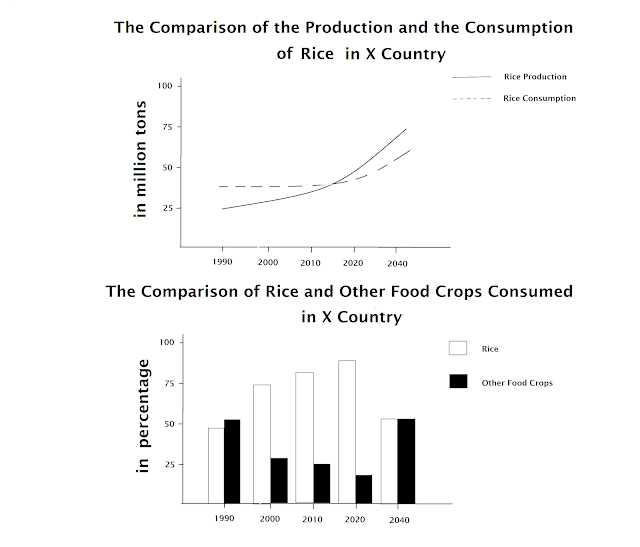In the previous article, we have discussed how to explain the combination of pie charts and bar graph. Today, we are going to continue the discussion for IELTS Writing Task 1 combined graphs. Take a look at a sample graph below.
 |
| IELTS Writing Task 1 Combined Graph (Line Graph & Bar Graph) |
The writing structure for sample graphs above is as follows:
Paragraph 1
- Introduction
- Explaining variables
- Explaining major trend
Paragraph 2
- Giving detailed information of major trend 1 (percentage, proportion, lowest/highest, increase/decrease)
Paragraph 3
- Giving detailed information of major trend 2 (percentage, proportion, lowest/highest, increase/decrease)
Remember that when describing combined graphs we can also use this writing structure:
Paragraph 1
- Introduction
- Explaining variables
- Explaining major trend
Paragraph 2
- Giving detailed information of the first graph (percentage, proportion, lowest/highest, increase/decrease)
Paragraph 3
- Giving detailed information of the second graph (percentage, proportion, lowest/highest, increase/decrease)
For now, I would like to focus on how we explain the two graphs in two separate paragraphs (instead of separating the two paragraph based on the major trend). Here's how we describe the sample graph above:
Paragraph 1
Introduction
As usual, we have to introduce the graph by paraphrasing the original title, which can be done as follows:
- The comparison of the production and the consumption of rice in X country (line graph original title)
- The comparison of rice and other food crops consumed in X country (bar graph original title)
- The line graph compares X country's domestic production and consumption of rice in forty years starting from 1990, while the bar graph compares the consumption of rice and other staples (paraphrased title)
Explaining Variables
There are a number of variables that we have to explain in the first paragraph, two of which (year and country) have been explained in the first sentence. SO now, we only have to explain the unit of measurement, which can be written like this:
- Units are measured in million tons
Explaining Major Trend
Although the two graphs are explained separately in two different paragraphs, we still have to use the major trend as the main idea of each paragraph, and it can be written as follows:
- The line graph indicates that both rice production and consumption increases throughout the period (the main idea for paragraph 2)
- It can be seen from the bar graph that unlike the consumption of rice, the amount of other produces tends to decrease (the main idea for paragraph 3)
So far, the first paragraph of our writing task 1 will look like this:
The line graph compares X country's domestic production and consumption of rice in forty years starting from 1990, while the bar graph compares the consumption of rice and other staples. Units are measured in million tons.
Paragraph 2
In paragraph 2, we have to give a more detailed explanation which can be done as follows:
The line graph indicates that both rice production and consumption increases throughout the period. The consumption of rice does not undergo any significant change from 1990 until 2020, during which around 37 million tons of rice is consumed. However, the domestic consumption of rice was way higher than the production. In 1990, there was a deficit of 12 million tons of rice. It took 25 years for the production and consumption to reach an equilibrium. From this point on, the production of rice is predicted to be higher than consumption and will reach its highest point of more than 75 million tons in 2040. The consumption of rice will also increase and reach 62 million tons in 2040.
Paragraph 3
In paragraph 3, we also have to give detailed information, which can be done as follows:
It can be seen from the bar graph that unlike the consumption of rice, the amount of other produces tends to decrease. In 1990, the consumption of other staples was just a little above 50%.Ten years later, the number was almost reduced by a half. The consumption other staples continued to decrease by 1% twenty years later. In 2040, it is estimated that there will be a balanced consumption of rice and other produces.
The whole writing will be like this:
The line graph compares X country's domestic production and consumption of rice in forty years starting from 1990, while the bar graph compares the consumption of rice and other staples. Units are measured in million tons.
The line graph indicates that both rice production and consumption increases throughout the period. The consumption of rice does not undergo any significant change from 1990 until 2020, during which around 37 million tons of rice is consumed. However, the domestic consumption of rice was way higher than the production. In 1990, there was a deficit of 12 million tons of rice. It took 25 years for the production and consumption to reach an equilibrium. From this point on, the production of rice is predicted to be higher than consumption and will reach its highest point of more than 75 million tons in 2040. The consumption of rice will also increase and reach 62 million tons in 2040.
It can be seen from the bar graph that unlike the consumption of rice, the amount of other produces tends to decrease. In 1990, the consumption of other staples was just a little above 50%.Ten years later, the number was almost reduced by a half. The consumption other staples continued to decrease by 1% twenty years later. In 2040, it is estimated that there will be a balanced consumption of rice and other produces.
Wordcount: 228 words

No comments:
Post a Comment